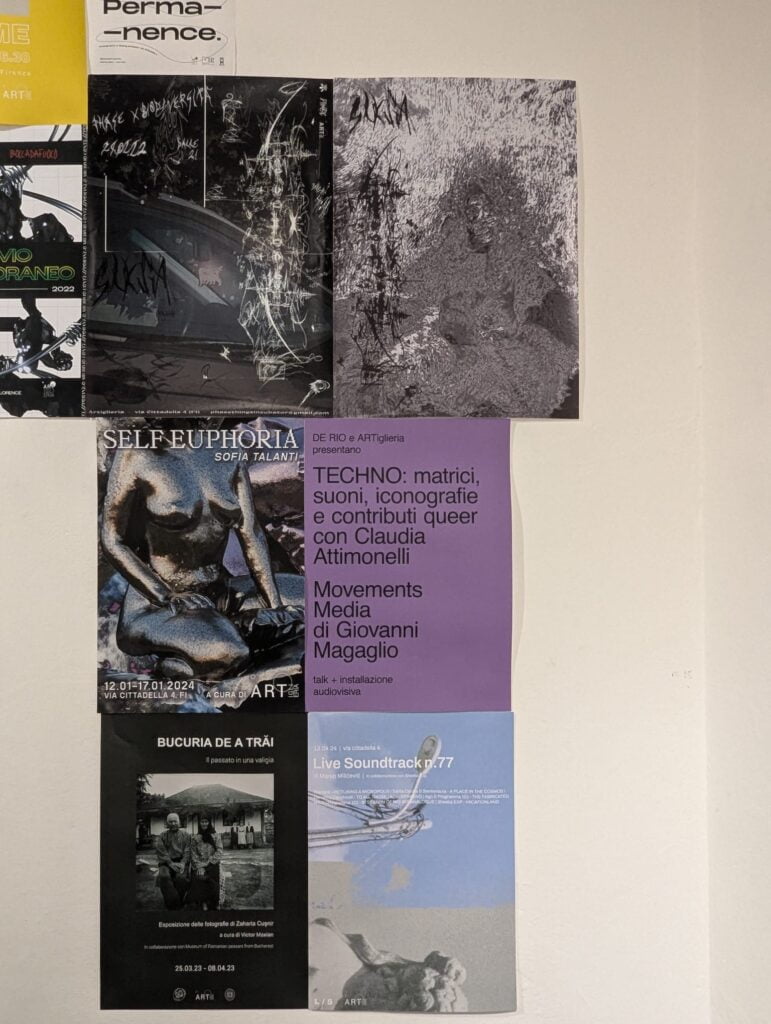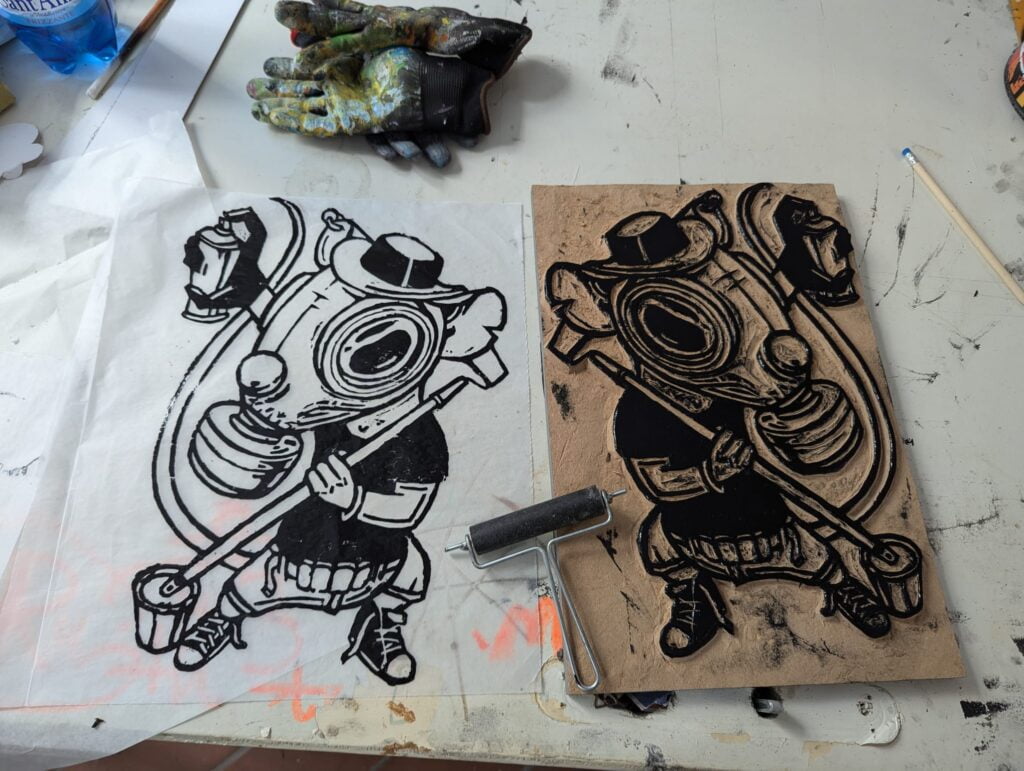Ana (the president of the association) and the artist Harcea Pacea vice president) traveled to Florence, Italy, with the support of Culture Moves Europe grant , where they took part in an artistic residency at A Testa Alta E.T.S. Association and Street Levels Gallery.
The host organization founded the first street art gallery in Florence and organizes projects in our field of activity (street art, graffiti, mural painting).
The residency took place between June 27 and July 18, 2024. The adventure began as early as June 25, when the artipics set off for Budapest, where they had the chance to visit the Central Market, stroll through Citadella Park and the Fisherman's Bastion area and enjoy some delicious lángos.
On June 26, they crossed Slovenia to reach Venice, which is stunning—partly because there are no cars in the old town. The center belongs to the people (a lot of people, to be fair), who get around by gondola or boat at most. They were impressed to discover street art pieces by Banksy, Space Invader, Ache77 and Exit Enter. In Venice, they passed through numerous small squares on their way to Piazza San Marco, where they enjoyed a 360-degree view from the San Marco tower and indulged in delicious artisanal pasta and what they described as the best ice cream in the world—flavored Crema dei Doge. They were delighted to find art installations exhibited in the Giardini della Marinaressa as part of the “Personal Structures” exhibition, organized by the European Cultural Center. They also had time to visit a second exhibition location at Palazzo Bembo before heading to the final destination of their journey—Florence.
During the first two days, we visited the association's studio (where we were also accommodated), Street Levels Gallery (which was hosting the group exhibition “Dinoasaurs” at the time), met the board of Associazione A Testa Alta E.T.S. and planned the schedule for our stay in Florence.
On June 28, we attended the opening of artist Lorenzzo's exhibition, hosted by Lumen – an initiative launched by a group of architects, who leased 8,000 m² of greenhouse land belonging to a former sanatorium for people with mental illnesses. The space had been abandoned until about 3 years ago, when an architecture studio leased it from the authorities for a 30-year period. They involved numerous local organizations to help develop an event space with an urban garden. The area is in continuous transformation, with plans to renovate the building using their own funds so it can host events during the winter as well. So far, they’ve organized over 200 events of all kinds (film screenings, sports matches, parties, concerts, workshops, conferences, martial arts training, exhibitions and more). What’s truly remarkable is that the initiative is both accessible (no entry fees for events) and sustainable (you pay 1 euro for a reusable cup, which you get back when returning the cup).
In the following days, we explored Florentine street art through tours of the old city center, the legal graffiti space at Le Cure underpass (which also serves as a shelter for over 10 homeless individuals), as well as through visits to peripheral neighborhoods where the host organization has created works that have transformed the urban landscape.
The following week, we visited the studios of Florentine artists - both from the street art scene (such as Clet, Exit Enter and Nian) and from the traditional arts (painters and sculptors). We were particularly impressed by the Artiglieria space - a ground floor in a central Florence apartment block, rented at a modest cost by an association to host artist workshops and also serve as a venue for parties and events.




In addition to the visits, the artist Harcea Pacea experimented with the printmaking technique - creating a woodcut, with which he made over 30 prints. At the studio, he also created a painting that was put up for auction to support the fundraising efforts of A Testa Alta, aimed at renovating the studio that hosted us. The studio was granted free of charge for a 15-year period to Associazione A Testa Alta E.T.S. by a network of NGOs led by Don Vicenzo Russo.
The Artipic members helped install the exhibition, participated in the press conference and the auction, which raised a total of €7,500. The space where the auction was held is quite unique, just like the story of Don Vicenzo - a priest excommunicated by the Catholic Church. Don Vicenzo used to serve in prisons and encouraged inmates to demand their rights, which angered prison administrators and led to complaints to Church leadership. Although no longer a part of the Catholic Church, he continued to help people by founding several humanitarian organizations (his humanitarian mission even reached Romania, in Bacău). He established a shelter center for homeless minors with criminal records who received home detention sentences. Through this initiative, young people are provided with a home where they can serve their sentence, thus avoiding incarceration in prison - a crucial intervention for minors with complex issues, including legal ones.
Harcea Pacea assisted the Romanian artist Kraita317, who is based in Florence, with setting up his solo exhibition at Ostro San Frediano - an event that ended with a party featuring DJs from Florence and Berlin.












Three evenings were dedicated to the “vandalization” of Florence’s streets by Harcea Pacea and other artists - Kraita317, Exit Enter and James Verga - who created street art interventions such as paste-ups and marker-based artworks.
While Harcea Pacea was working on these street interventions, Ana was developing ideas for future collaborations with the board of Associazione A Testa Alta, inspired by their organizational model. She drafted a project proposal that is planned to be submitted for funding to the National Cultural Fund Administration (AFCN) in September (fingers crossed it gets selected).
In his characteristic style, the residency couldn’t end without some mural interventions. Harcea Pacea and Kraita 317 created two works at Ponte all'Indiano, a space dedicated to street art, graffiti and mural painting.
Before leaving, Harcea Pacea also completed a piece on a shattered door of a commercial space near Street Levels Gallery.
Since the Renaissance began in Florence, the opportunity to visit museums and galleries showcasing Renaissance works could not be missed. This led the artipics to Palazzo Vecchio and the Uffizi Gallery, where they experienced an artistic journey from Antiquity to the Middle Ages, all the way to the Renaissance (a fascinating observation of the evolution of art).
The Artipic members also organized a workshop at Lumen, testing a format they had been planning for some time. The goal was to give new life to empty paint tubes - waste materials that can’t be recycled but can be transformed and reused as art objects, souvenirs, gifts or decorative items. Participants painted the empty paint tubes with leftover paint from spray cans and markers.
In addition to the street art interventions, Harcea Pacea created two works on canvas and two on empty paint tubes, which he gifted to other artists and people he met during the residency.
On the way back home, a stop in Bologna (the city with the oldest university in Europe) was a must. A short visit revealed Bologna’s street art scene and the city center inspired Harcea Pacea to create small artistic interventions.
On their return journey, the artipics made a stop in Ljubljana, where they visited the Metelkova Autonomous Cultural Centre - a community cultural space with a fascinating history.
The space was once a military base for the Austro-Hungarian Empire and later became a military base for the Yugoslav army. It consists of 7 barracks (spanning an area of 12,500 m²) that were squatted in 1993. The squatting of the area began in 1991 by the Network for Metelkova, made up of 200 youth groups and organizations who asked the Ljubljana municipality for permission to use the barracks for peaceful and creative purposes. The authorities granted the network formal permission to stay and use the barracks, although the promise made was never kept. The authorities' ambiguity remained over time and in 1993, plans were made to demolish some of the barracks to illegally construct a commercial space. Since then, Metelkova has been a squat and was reorganized as an autonomous social space in 1995. Today, Metelkova houses several NGOs and LGBT associations. There are legal walls for drawing and it hosts exhibitions, concerts, performances and social involvement activities. We recommend searching for more information about Metelkova Centre and visiting it if you find yourself in Ljubljana (it is definitely worth it).
This work was produced with the financial assistance of the European Union. The views expressed herein can in no way be taken to reflect the official opinion of the European Union.

































































